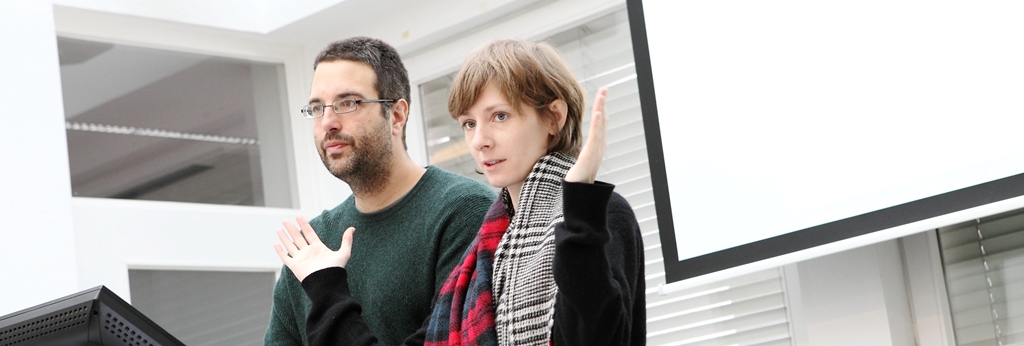Challenging questions at the intersections of art, pedagogy, and research
An Interview with microsillons (Marianne Guarino-Huet and Olivier Desvoignes) by Laila Huber and Elke Zobl
The artists Marianne Guarino-Huet and Olivier Desvoignes who together form microsillons, were our guests at the “Artistic Interventions and Collaboration in Anti-Racist and Feminist Artistic-Educational Projects” Symposium at the Program Area Contemporary Arts & Cultural Production in December 2013. In the interview they discuss how they developed their approach of combining arts and pedagogy, working with different audiences and different forms of collaboration, as well as the interventionist aspects of their artistic and research practice and critical art education in Switzerland.*1 *(1)
Our first question is about your artistic practice, which is mainly collaborative, linking research practice with art and critical pedagogies. Can you explain what the artistic part of this is and where the critical pedagogies come in?
Marianne Guarino-Huet: Maybe we can trace back a bit to how we started working together and how we built our theoretical background from the first project we did together when we were still students at the arts school in Geneva. We were both studying at the Critical Curatorial Cybermedia Program at the Geneva University of Art and Design. One of the assignments was to develop a collaborative project. It was a project with two secondary classes from the state school and the aim was to propose a day of symposia presentations for teachers who were attending a lifelong learning program for art teachers.
Olivier Desvoignes: We decided to involve the pupils and the students themselves, which was not necessarily a requirement of the project. We were very interested in the idea of collaboration and trying to form something together with non-artists. At that time we were interested in questions of education, but a bit loosely, and through doing the project and through the exchange with the participants, we realized that it was something that was very exciting to do. We didn’t ask ourselves, “Is it education? Is it art?”: For us, everything has merged completely right from the start. We both have art training, and neither of us has educational training, but we have practice in education at different levels. For us, it is really not about separating, but finding a way to hybridize, to mix those interests in art and education.
Marianne Guarino-Huet: We are making the road while walking. For each project we develop a specific collaborative structure and a specific content because the context is always different. For the specific groups of people we work with, there is also a need to have specific inputs.
Olivier Desvoignes: We have to point out two things regarding the question of artistic practice: First, for us it is truly the idea of producing something together and producing something that will be made public. Because we noticed it is a completely different relationship with the participants when we simply say, it is a kind of internal workshop, as opposed to saying, we are doing something that will be exhibited. A lot of questions regarding who you are addressing and the responsibilities of what you say come up this way.
And the second point is that we always try to consider our art practice as not only handcraft production. So very often in our projects the participants are not doing anything with their hands, they are conceptualizing, making models. So in a way this is different from what people we are working with are used to: in the art classes at school they are still doing traditional art practices, such as modeling or painting, which is another type of learning. That’s a point where we differ from school.
Marianne Guarino-Huet: We are somehow very close to the idea of learning through art. It is really using art as a sphere where the political, the critical, the social, all kinds of different problem areas can meet. We can reflect on those issues through the collective production of the work.
Laila Huber, Elke Zobl, microsillons – Olivier Desvoignes/Marianne Guarino-Huet ( 2014): Challenging questions at the intersections of art, pedagogy, and research. An Interview with microsillons (Marianne Guarino-Huet and Olivier Desvoignes) by Laila Huber and Elke Zobl . In: p/art/icipate – Kultur aktiv gestalten # 05 , https://www.p-art-icipate.net/challenging-questions-at-the-intersections-of-art-pedagogy-and-research/


 Artikel drucken
Artikel drucken Literaturverzeichnis
Literaturverzeichnis